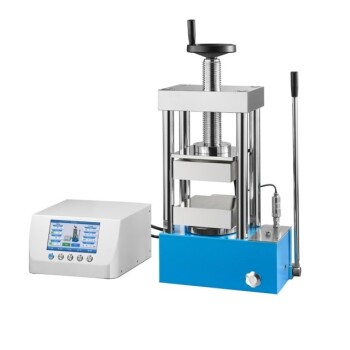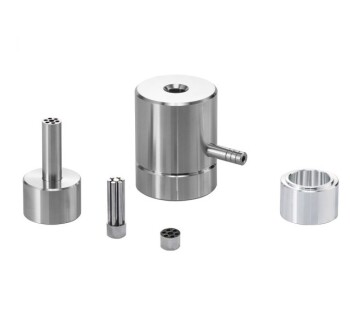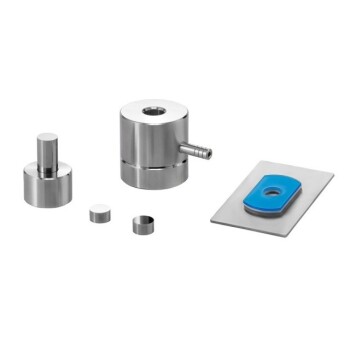At its core, a laboratory hot press is an integrated system of five key components. These are the Heating System to apply thermal energy, the Pressing System to apply mechanical force, the Control System to manage parameters, a robust Frame for structural integrity, and various optional Auxiliary Systems for specialized processes.
A hot press is more than a simple heater and a press. It is a precision instrument where each component—from the heating elements to the control software—must work in perfect concert to achieve repeatable and accurate material processing. Understanding how these systems interact is the key to mastering its use.
The Heating System: Delivering Thermal Energy
The primary function of the heating system is to deliver precise and uniform thermal energy to the material sample.
Heating Platens
The heating platens are the flat, temperature-controlled surfaces that directly contact the mold or sample. They are responsible for transferring heat efficiently and evenly.
These are often made from materials like steel or specialized alloys like titanium to ensure excellent temperature distribution and durability under pressure.
Heating Elements and Sensors
Embedded within or attached to the platens are heating elements (like cartridge heaters) that generate the heat.
Temperature sensors, such as thermocouples, are placed strategically within the platens to provide real-time feedback to the control system, ensuring the target temperature is accurately maintained.
The Pressing System: Applying Mechanical Force
This system is responsible for generating and applying the compressive force required for forming, bonding, or curing materials.
The Drive Mechanism
The force is typically generated by one of three methods:
- Hydraulic Systems: Use incompressible fluid to generate very high, controllable forces, ideal for most research and production applications.
- Pneumatic Systems: Use compressed air for faster-acting, lower-force applications.
- Manual Systems: Use a hand-operated screw or lever, suitable for low-pressure applications where high precision is not the primary goal.
The Ram and Platen Assembly
A ram or piston, driven by the hydraulic or pneumatic system, moves one of the platens (typically the upper one) to press against the fixed lower platen, compressing the sample between them.
The Control System: The Brain of the Operation
The control system orchestrates the heating and pressing systems, allowing for precise and repeatable process cycles.
Temperature and Pressure Controllers
These controllers are the heart of the system. Modern presses use digital controllers (often PID controllers) that continuously monitor sensor feedback and adjust power to the heaters or pressure to the ram.
Advanced systems offer features like multi-stage temperature programming, allowing you to define complex heating, holding, and cooling ramps for sophisticated material processing.
Timers and the Human-Machine Interface (HMI)
A timer allows the user to set the duration for which pressure and temperature are applied.
The HMI, which can range from simple digital readouts to a full touchscreen graphical interface, is where the operator sets all parameters—temperature, pressure, time—and monitors the process in real-time.
The Frame: Providing Structural Integrity
The frame is the skeleton of the hot press, designed to safely contain the immense forces generated during operation.
The Core Structure
Most laboratory presses use a heavy-duty steel frame, often in a four-column structure, to resist deflection and ensure the platens remain parallel under load.
The size of the frame and the distance between the platens determine the maximum size of the product that can be processed.
Safety Features
Integrated safety features are critical. These include emergency stop buttons, physical guards or safety doors to enclose the pressing area, and over-pressure or over-temperature software shutoffs.
Understanding the Trade-offs
Choosing or operating a hot press involves balancing competing factors. Your application dictates which components and features are most critical.
Hydraulic vs. Pneumatic Force
A hydraulic system offers significantly higher force and finer control, making it the standard for materials research and consolidation. A pneumatic system offers speed but at the cost of lower, less precise force.
The Importance of Control Precision
For basic curing, a simple temperature controller might suffice. For developing new alloys or polymers, a system with precise temperature sampling (e.g., 0.1s), multi-stage programming, and real-time data logging is essential to understand material behavior.
Evaluating Optional Systems
Do not overlook auxiliary systems. A vacuum system is critical for preventing oxidation in sensitive materials. An active cooling system (using water or air) dramatically reduces cycle times and allows for controlled cooling rates, which can be a vital process parameter.
Making the Right Choice for Your Goal
Your intended application should guide your focus when evaluating a hot press configuration.
- If your primary focus is advanced materials research: Prioritize a high-precision control system with programmable ramps, data logging, and auxiliary options like vacuum and controlled cooling.
- If your primary focus is small-batch production or curing: Emphasize platen size, the robustness of the hydraulic system, and features that ensure cycle-to-cycle repeatability.
- If your primary focus is basic sample preparation or teaching: A simpler manual or pneumatic press with basic digital controls for temperature and pressure is often sufficient and more cost-effective.
By understanding each component's role and function, you can move from simply operating the equipment to truly engineering a process.
Summary Table:
| Component | Key Features | Primary Function |
|---|---|---|
| Heating System | Heating platens, elements, sensors | Deliver precise and uniform thermal energy |
| Pressing System | Hydraulic, pneumatic, or manual drive | Apply mechanical force for forming/bonding |
| Control System | Digital controllers, HMI, timers | Manage temperature, pressure, and process cycles |
| Frame | Four-column structure, safety features | Provide structural integrity and safety |
| Auxiliary Systems | Vacuum, cooling options | Enable specialized processes like oxidation prevention |
Ready to enhance your lab's capabilities with a reliable hot press? KINTEK specializes in lab press machines, including automatic lab presses, isostatic presses, and heated lab presses, designed to meet the needs of research and production laboratories. Our equipment ensures precise temperature control, uniform heating, and robust performance for materials like polymers and alloys. Contact us today to discuss how we can support your specific applications and boost your efficiency!
Visual Guide

Related Products
- 24T 30T 60T Heated Hydraulic Lab Press Machine with Hot Plates for Laboratory
- Heated Hydraulic Press Machine with Heated Plates for Vacuum Box Laboratory Hot Press
- Automatic High Temperature Heated Hydraulic Press Machine with Heated Plates for Lab
- Manual Heated Hydraulic Lab Press with Integrated Hot Plates Hydraulic Press Machine
- Automatic Heated Hydraulic Press Machine with Hot Plates for Laboratory
People Also Ask
- What role do heated hydraulic presses play in manufacturing composite materials? Enhance Strength and Precision in Production
- What are the advantages of using a hydraulic heat press? Achieve Precision and Efficiency in Material Processing
- How do hydraulic hot press machines enhance operational efficiency? Boost Productivity with Precision and Automation
- How are heated hydraulic presses utilized in material testing and sample preparation? Enhance Your Lab's Precision and Efficiency
- How is a hydraulic heat press used in laboratory sample preparation? Create Uniform Samples for Accurate Analysis



















